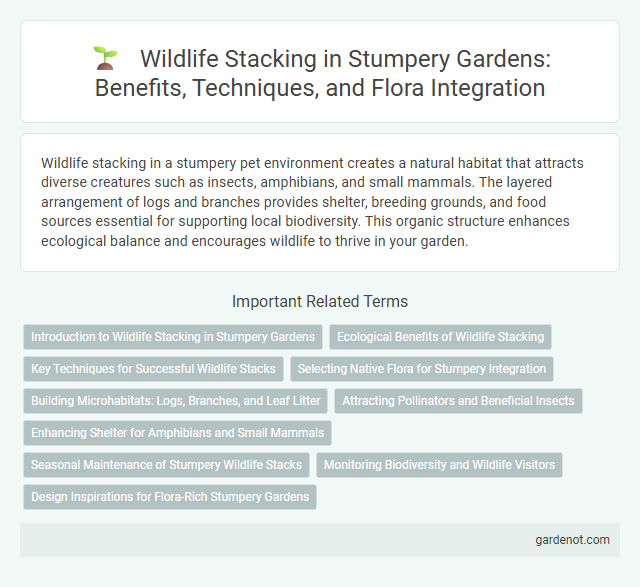Wildlife stacking in a stumpery pet environment creates a natural habitat that attracts diverse creatures such as insects, amphibians, and small mammals. The layered arrangement of logs and branches provides shelter, breeding grounds, and food sources essential for supporting local biodiversity. This organic structure enhances ecological balance and encourages wildlife to thrive in your garden.
Introduction to Wildlife Stacking in Stumpery Gardens
Wildlife stacking in stumpery gardens involves the strategic arrangement of logs, branches, and stumps to create habitats that support diverse fauna such as insects, amphibians, and birds. These structures provide shelter, breeding sites, and food sources, enhancing biodiversity within woodland environments. Incorporating wildlife stacking into stumpery design promotes ecological balance and fosters a thriving natural ecosystem.
Ecological Benefits of Wildlife Stacking
Wildlife stacking, a key aspect of stumpery design, enhances biodiversity by creating diverse microhabitats for insects, amphibians, and small mammals. Decaying wood structures improve soil health through nutrient cycling and support fungal growth critical for forest ecosystems. These habitats also serve as vital shelter and breeding grounds, promoting ecological resilience and species diversity.
Key Techniques for Successful Wildlife Stacks
Wildlife stacking relies on key techniques such as selecting diverse natural materials like logs, branches, and leaves to mimic animal habitats effectively. Ensuring structural stability by interlocking pieces provides safe shelter for insects, amphibians, and small mammals. Positioning stacks in shaded, moist areas enhances biodiversity by maintaining optimal microclimates for wildlife activity.
Selecting Native Flora for Stumpery Integration
Selecting native flora such as ferns, mosses, and woodland wildflowers enhances wildlife stacking in stumperies by providing food, shelter, and breeding habitats. Incorporating species like wood anemone, wild ginger, and Solomon's seal supports local pollinators and amphibians, promoting biodiversity. Native plants adapted to the local soil and climate ensure sustainable growth and ecological balance within the stumpery environment.
Building Microhabitats: Logs, Branches, and Leaf Litter
Stumperies optimize wildlife stacking by strategically arranging logs, branches, and leaf litter to create diverse microhabitats that support insects, amphibians, and small mammals. Deadwood structures retain moisture and provide shelter, fostering fungal growth and promoting biodiversity. Leaf litter layers encourage decomposers, enhancing soil health and sustaining intricate ecological networks within the stumpery ecosystem.
Attracting Pollinators and Beneficial Insects
Stumperies provide intricate wood structures that create ideal habitats for pollinators such as bees and butterflies, promoting biodiversity in garden ecosystems. The combination of decaying wood and shaded, moist microclimates attracts beneficial insects like ladybugs and lacewings, which help control pest populations naturally. Incorporating native flowering plants alongside stumperies further enhances their potential to support pollinator activity and sustain healthy populations of beneficial insects.
Enhancing Shelter for Amphibians and Small Mammals
Stumperies provide vital wildlife stacking by creating dense shelters from logs, branches, and root systems that mimic natural habitats for amphibians like frogs and newts, as well as small mammals such as hedgehogs and voles. These layered wood piles retain moisture and offer protection from predators and harsh weather, fostering biodiversity in garden ecosystems. Incorporating varied textures and sizes of wood enhances microhabitats, promoting breeding and nesting opportunities for multiple species.
Seasonal Maintenance of Stumpery Wildlife Stacks
Seasonal maintenance of stumpery wildlife stacks involves removing accumulated debris to prevent mold and decay while preserving natural habitats for insects, amphibians, and small mammals. Regular inspection during spring and autumn ensures structural stability and encourages biodiversity by allowing sunlight and rainwater to nourish the microhabitats. Enhancing habitat complexity with freshly gathered logs and branches supports species diversity and promotes ecological balance throughout changing seasons.
Monitoring Biodiversity and Wildlife Visitors
Wildlife stacking in stumperies creates diverse habitats that support a wide range of species, enhancing biodiversity monitoring efforts. Careful arrangement of logs and branches provides shelter, nesting sites, and foraging opportunities, attracting various wildlife visitors such as insects, amphibians, and small mammals. Regular observation of these visitors offers valuable data for ecological studies and conservation strategies.
Design Inspirations for Flora-Rich Stumpery Gardens
Wildlife stacking in stumpery design enhances habitat complexity by layering fallen logs, branches, and decaying wood to create microhabitats for diverse flora and fauna. Incorporating native plants such as ferns, mosses, and shade-tolerant perennials around stumps fosters rich biodiversity and supports pollinators and detritivores. Emulating natural woodland debris patterns inspires sustainable stumpery gardens that blend ecological function with aesthetic appeal.
Wildlife stacking Infographic

 gardenot.com
gardenot.com